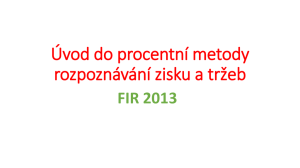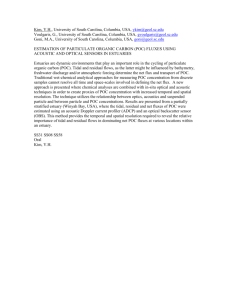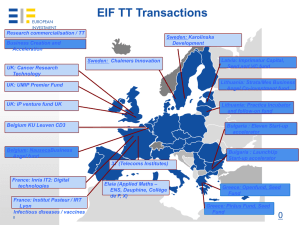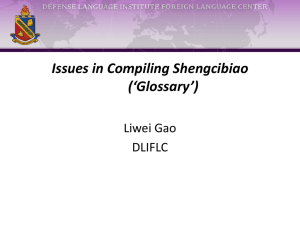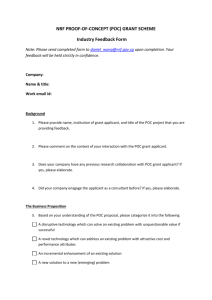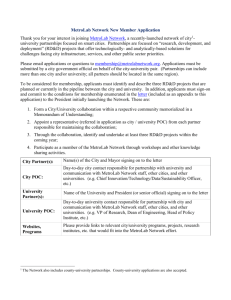Doc 4a Rev 1
advertisement
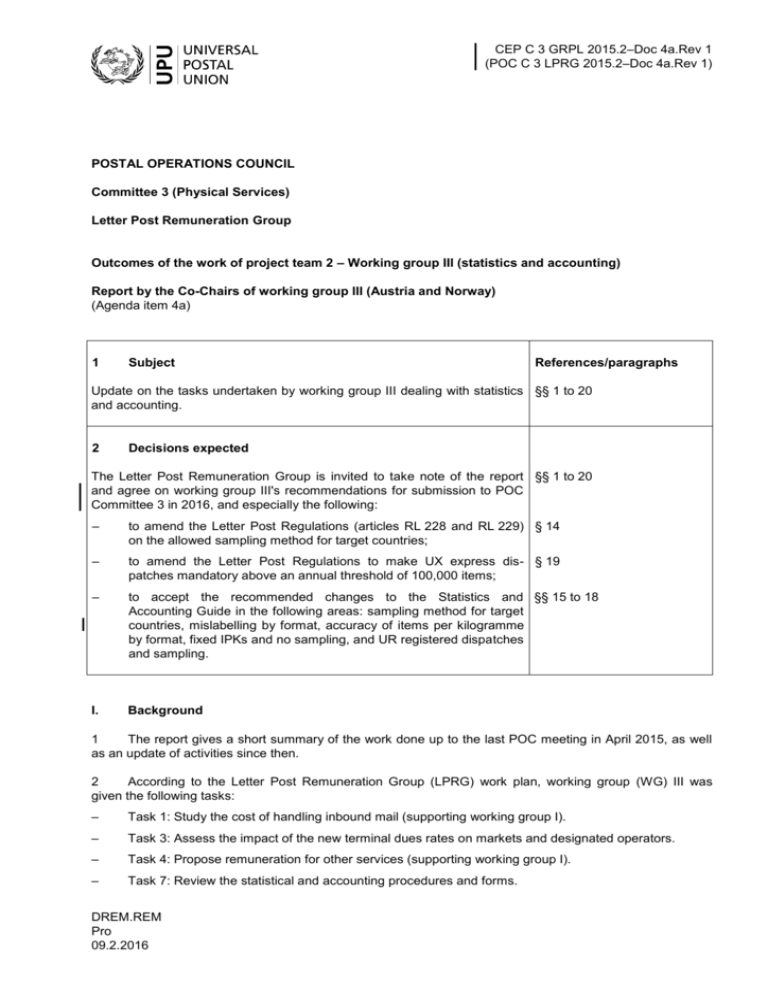
CEP C 3 GRPL 2015.2–Doc 4a.Rev 1 (POC C 3 LPRG 2015.2–Doc 4a.Rev 1) POSTAL OPERATIONS COUNCIL Committee 3 (Physical Services) Letter Post Remuneration Group Outcomes of the work of project team 2 – Working group III (statistics and accounting) Report by the Co-Chairs of working group III (Austria and Norway) (Agenda item 4a) 1 Subject References/paragraphs Update on the tasks undertaken by working group III dealing with statistics §§ 1 to 20 and accounting. 2 Decisions expected The Letter Post Remuneration Group is invited to take note of the report §§ 1 to 20 and agree on working group III's recommendations for submission to POC Committee 3 in 2016, and especially the following: – to amend the Letter Post Regulations (articles RL 228 and RL 229) § 14 on the allowed sampling method for target countries; – to amend the Letter Post Regulations to make UX express dis- § 19 patches mandatory above an annual threshold of 100,000 items; – to accept the recommended changes to the Statistics and §§ 15 to 18 Accounting Guide in the following areas: sampling method for target countries, mislabelling by format, accuracy of items per kilogramme by format, fixed IPKs and no sampling, and UR registered dispatches and sampling. I. Background 1 The report gives a short summary of the work done up to the last POC meeting in April 2015, as well as an update of activities since then. 2 According to the Letter Post Remuneration Group (LPRG) work plan, working group (WG) III was given the following tasks: – Task 1: Study the cost of handling inbound mail (supporting working group I). – Task 3: Assess the impact of the new terminal dues rates on markets and designated operators. – Task 4: Propose remuneration for other services (supporting working group I). – Task 7: Review the statistical and accounting procedures and forms. DREM.REM Pro 09.2.2016 2 – Task 8: Review developments on handling costs for mail in transit (supporting working group I). – Task 9: Review the bulk mail provisions. – Task 10: Conduct an items per kilogramme (IPK) study. – Task 11: Conduct a flow study. II. Work done up to POC meetings in April 2015 3 Task 1 – Study the cost of handling inbound mail – The results were presented at the POC meetings in October 2013 in document POC C 3 LPRG 2013.2–Doc 3. – Twelve countries gave full cost data. – Cost-to-tariff ratio of 60–65% for the target system (nine replies). 4 Task 3 – Assess the impact of the new terminal dues rates on markets and designated operators – The results were presented at the POC meetings in October 2014 in document POC C 3 LPRG 2014.2–Doc 4c. – Subjects addressed were sampling, format separation, terminal dues (TD), quality of service link to terminal dues and Quality of Service Fund (QSF). – The quality of service link to terminal dues was clearly identified as a positive aspect of the terminal dues target system, but there was no clear picture for the other subjects. 5 Task 4 – Propose remuneration for other services – The results were presented at the POC meetings in April 2015 in document POC C 3 LPRG 2015.1– Doc 4a. – The following areas were analyzed: registered, insured and express; IBRS and advice of delivery; M bags; pay-for-performance for registered, insured and express; non-compliance with standard S10. – There were 38 replies in total, but for some questions the number of replies was as low as two to four. – The median cost for a registered letter was 1.130 SDR (in 2013). – For IBRS and advice of delivery, the number of replies was very low. There was no clear indication that the remuneration principles should be changed. There was a majority in support of keeping the principles unchanged in the Regulations. – For M bags, the number of replies was low. There was no clear indication as to whether the cost is lower or higher than the remuneration received. The working group recommends continuing to adjust the rates using the same percentage as the increase of the floor rates. – For pay-for-performance for registered, insured and express, there was a clear majority in favour of keeping the remuneration at 0.50 SDR per item, subject to the conditions and transmission targets set out in the provisions concerning the supplementary remuneration programme. – For non-compliance with standard S10, there was a clear majority in favour of keeping the current remuneration. 6 Task 7 – Review the statistical and accounting procedures and forms – The work achieved includes: Included bias in the accuracy calculation; 3 Determined the thresholds for sampling and format segregation; Developed an Excel spreadsheet tool for the calculation of the sample rates; Changed continuous sampling from an alternative to the recommended sampling method; Allowed the use of the dispatch date on the e53. 7 Task 8 – Review developments on handling costs for mail in transit – The results were presented at the POC meetings in October 2014 in document POC C 3 LPRG 2014.2–Doc 4b. – On the basis of the working group's recommendations, the LPRG submitted proposals to the 2015.1 POC C 3, which adopted the following changes to rates: The rate for items in closed transit was changed to 0.530 SDR per kilogramme. The rate for items in open transit was changed to 0.980 SDR per kilogramme. – The rate for missent items was kept at 2.00 SDR per kilogramme. 8 Task 9 – Review the bulk mail provisions – The results were presented at the POC meetings in October 2014 in document POC C 3 LPRG 2014.2–Doc 4d. – There was a clear majority (71%) in support of the continuation of the bulk mail provisions as they stand. There was no majority for the changing of deadlines, or for which countries can apply the provisions, etc. 9 Task 10 – Conduct an IPK study – The results were presented at the POC meetings in October 2014 in document POC C 3 LPRG 2014.2–Doc 4a. – The worldwide IPK was calculated at 10.88 (down from 12.23 used for 2014–2017). – IPKs were calculated for the different formats P, P/G, G and E and adopted by the POC in document POC C 3 2015.1–Doc 5b. – Gross-to-net adjustment factors were calculated for different receptacle types. The figures can be found in document POC C 3 LPRG 2014.2–Doc 4a. – Mail structure by weight step and format was provided. The figures can be found in document POC C 3 LPRG 2014.2–Doc 4a. III. Work done after the POC meetings in April 2015 10 Task 11 – Conduct a flow study – Eighty operators responded to the questionnaire. – The main conclusions of the study were as follows: In the target system, there are few flows between 50 and 125 tonnes. For group 4 and 5 countries, approximately 98% of the flows received are below 50 tonnes. Approximately 89% of the weight is priority mail (including UR registered dispatches). UR registered dispatches represent in some relations a high proportion of the weight (especially mail sent from group 1.2/2 to group 3). 11 Report on revision mechanism – A task force looked at the current rules and recommended changes. 4 – Some of the changes recommended were as follows: Change the lower and upper IPK limits from 10 and 15 to 8 and 13 respectively (to reflect the lower IPK from the latest IPK study, i.e. from the current IPK of 12.23 down to 10.88). The sampling to invoke the revision mechanism should be done in the second quarter of the year. UR registered dispatches should not be sampled, but included in the IPK. The threshold for invoking the revision mechanism should be the same as the sampling threshold for group 3. The revision mechanism starts the following calendar year. The IPK from the sampling during that year will be used even if the overall IPK falls between the lower and upper limits (recommended at 8 and 13 for 2018–2021). However, if the overall IPK falls between the lower and upper limits, the revision mechanism will not be applied for the following year. 12 Report on the use of net weight in accounting – A task force was asked to look at the implications of using net weight in accounting. – The task force looked at the following issues: Determination of the net weight; Changes needed on the different accounting forms; Terminal dues implications with the use of different receptacle types. – The conclusion was that the terminal dues rates had to be adjusted for the use of net weight. As most operators are at the cap rate of the target system, the use of net weight without any adjustment of the rates would move these operators further away from cost covering. It is difficult to find the correct adjustment factor, as some operators receive mail only in bags, while other operators receive a mixture of bags and other receptacles. – The use of trays would improve quality of service and reduce damage to items. However, the increased terminal dues to be paid for using trays could deter some operators from this practice. – The results of the analysis will be given to working group I of the LPRG for further consideration. 13 Accounting for IBRS and advice of delivery – For the return of IBRS items and advices of delivery, there are two parts to the compensation: one is for the domestic handling and the other for the international conveyance. For the international conveyance, the net weight is to be used. This is difficult to follow when the items are returned in separate receptacles. – The recommendation is to use net weight for bundles and gross weight for receptacles to calculate the compensation. – A task force will develop a spreadsheet to calculate the IBRS rate, to be available as a tool on the UPU website. The spreadsheet will soon be available on the UPU website. 14 Sampling method – There are many disadvantages to using 48-day sampling. Working group III believes that continuous sampling has so many advantages that it should be made mandatory within the target system. At the same time, the working group acknowledges that it is difficult to change the sampling method quickly. – It is recommended that the LPRG propose to the POC, in February 2016, that continuous sampling be made mandatory within the target system (see articles RL 228 and RL 229) starting from 2017 with a three-year grace period. 15 Mislabelling by format – Mislabelling by format occurs when there is no letter-post item of the indicated format in the receptacle. 5 – WG III recommends making it clear that these receptacles can either be kept in the announced format or removed to the (most) correct format, but, if the format is changed, this has to be done for sampled and non-sampled mail. 16 Accuracy of IPKs by format – There is currently only one accuracy target, that is, +5% for the whole flow, in accordance with article RL 228. – WG III recommends including accuracy targets for the IPKs of P/G and E in the Statistics and Accounting Guide. The recommended accuracy targets for the IPKs are +7% for P/G and +15% for E. The target of +5% for the whole flow has to be met. 17 Fixed IPKs and no sampling – A study showed the inaccuracies associated with the use of fixed IPKs per format. Mis-segregation by format can have a large influence on the terminal dues to be paid. – The majority of WG III members are of the opinion that a fixed overall IPK should be used if the flow is below the sampling threshold, even if the mail has been format-separated. 18 UR registered dispatches and sampling – The Regulations provide an accuracy target for the estimation of the total number of items. – UR registered dispatches are not sampled, but the number of items is known through a full census count. – The Statistics and Accounting Guide will be updated to show how to calculate the overall accuracy combining the sampled and the full-census-counted mail. 19 UX express dispatches: WG III recommends making UX dispatches mandatory if the annual flow is more than 100,000 items (designated operator to designated operator). This is the same threshold as for UR registered dispatches. 20 Bulk mail – There is currently no format indicator for bulk mail on the CN 32 letter bill, but, if the mail is received format-separated, the announced format is needed in order to deduct the weight from the correct format. – The POC C 1 Operations and Accounting Review Group has been given the task of studying and making recommendations on a possible change to the CN 32 letter bill form for bulk mail. – WG III also recommends abolishing the use of bulk mail between two operators in the same group where sampling is done. The terminal dues rates are the same and the sampling will reflect the whole mail flow. The use of bulk mail will distort the accuracy of the sampling. Berne, 26 October 2015 Stig Brox and Thomas Greilinger Co-Chairs of working group III

